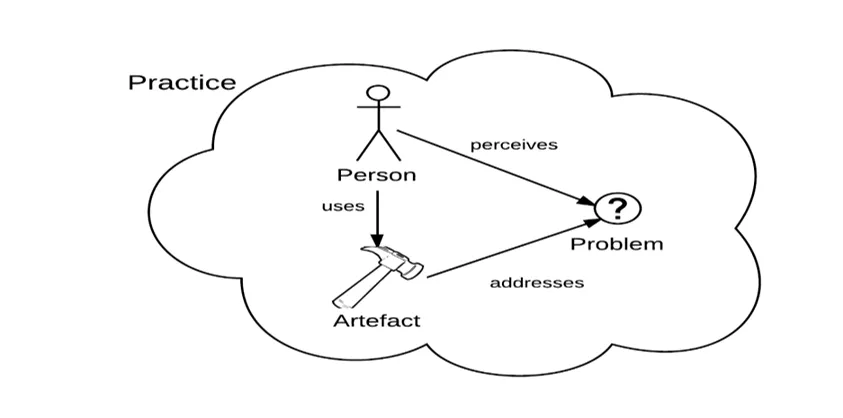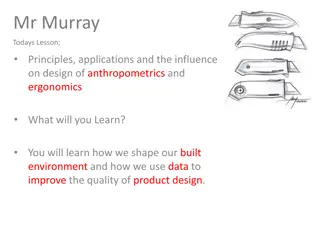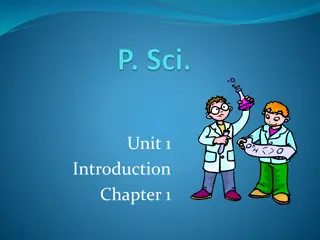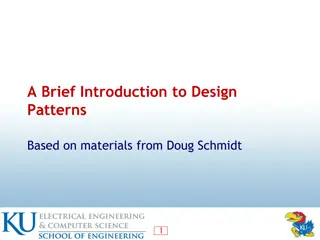Understanding Design Science: Concepts and Applications
Design science involves the study and creation of artefacts to solve practical problems, aiming to improve and change the future by developing objects for real-world applications. This field positions itself between natural science and social science, focusing on empirical research and introducing innovative solutions. Artefacts in information systems play a vital role, including IT systems, algorithms, models, methods, and instantiations. By defining artefacts and practices, design science offers a structured approach to problem-solving and goal achievement.
Download Presentation

Please find below an Image/Link to download the presentation.
The content on the website is provided AS IS for your information and personal use only. It may not be sold, licensed, or shared on other websites without obtaining consent from the author. Download presentation by click this link. If you encounter any issues during the download, it is possible that the publisher has removed the file from their server.
E N D
Presentation Transcript
Introduction to Design Science Erik Perjons Department of Computer and Systems Sciences (DSV), Stockholm University
Positioning design science Natural Science Social Science Design Science Empirical science - aims at describing and explaining the actual world in the present (as- is) or the past (has been) Design science - aims at improve and change the world in the future (to-be) - by developing and introducing artefacts in practice
Defining design science Design science is the scientific study and creation of artefacts as they are developed and used by people with the goal of solving practical problems of general interest
Defining artefact An artefact is an object made by humans with the intention to be used to address a practical problem in a practice
Artefact types in information systems IT system Algorithm Prototype of an IT system Notation Method Metric Model Pattern Guidelines Socio-Technical system Requirements
Artefact types in information systems Usually, four types of artefacts are presented when introduce design science (March & Smith, 1995): Construct is a term, notation, concept needed for formulate problems and their possible solutions Model is a representation of possible solution, that is, a model can be used for supporting construction of other artefact Method defined guidelines and processes of how to solve problems and achieve goals Instantiation is a working system that can be used in practice
Artefact and practice An artefact is an object made by humans with the intention to be used to address a practical problem in a practice
Defining practice A practice is a set of human activities performed regularly and seen as meaningfully related to each other by the people participating in them.
An example of a practice The practice of dentists is an example a practice Dentist are engaging in cleaning teeth, drilling teeth, taking X-rays, and many other activities. To carry out the practice, dentists make use of artefacts, such as pliers, drills, X-ray machines, and other tools
What characterize design science? The artefact developed in a design science project needs to be novel, something new and original, not previously developed
What characterize design science? The artefact developed in a design science initiative needs to be novel, something new and original, not previously developed The artefact is the solution that needs to be developed to address the problem
What characterize design science? The artefact developed in a design science initiative needs to be novel, something new and original, not previously developed The artefact is the solution that needs to be developed to address the problem The artefact needs to be used in a practice
What characterize design science? The problem needs to be a problem in a practice The artefact developed in a design science initiative needs to be novel, something new and original, not previously developed The artefact is the solution that needs to be developed to address the problem The artefact needs to be used in a practice
What characterize design science? The problem needs to be a problem in a practice The artefact developed in a design science initiative needs to be novel, something new and original, not previously developed The problem needs to be generic, that is, a solution not only for one organization The artefact is the solution that needs to be developed to address the problem The artefact needs to be used in a practice
Design science and Practice research Design science is often seen as part of what is called practical research Practice research is research that addresses problems in practices
Design science and Practice research Design Science Project [Inspired by Goldkuhl, 2012]
A design science framework Initial problem Explicate problem Explicated problem Define require- ments on artefact Requirements Design and develop artefact Artefact Demon- strate artefact Demonstrated artefact Evaluated artefact Evaluate artefact [Inspired by Peffer, et al, 2007]
A design science framework Initial problem Explicate problem Explicated problem Define require- ments on artefact Requirements Design and develop artefact Artefact Demon- strate artefact Demonstrated artefact In this activity, the problem needs to be precisely formulated and justified by showing that it is significant for some practice Evaluated artefact Evaluate artefact
Explicate problem Two categories of problems, and both need to be stated: Practical problem is an issue for practitioners in the practice that they want to be addressed Knowledge problem is often a knowledge gap in research Example of practical problem: The difficulty of finding and selecting appropriate best practices (BPs) in large collections of BPs impedes the use of BPs. Example of knowledge problem: There is a lack of knowledge/research of how to find and select appropriate best practices (BPs) in BP repositories.
A design science framework Defining requirements can be seen as a transformation of the problem into demands on the proposed artefact. Initial problem Explicate problem Explicated problem Define require- ments on artefact Requirements Design and develop artefact Artefact Demon- strate artefact Demonstrated artefact In this activity, the problem needs to be precisely formulated and justified by showing that it is significant for some practice Evaluated artefact Evaluate artefact
Define requirement Two categories of requirements: Features/Functions for example, the artefact should support communcation between decision makers Generic qualities for example, the artefact should be should be easy to use for the users
Define requirements Example of requirements in form of generic qualities: Understandability: The artefact should be easy to comprehend for the users, since they need use it in an effective way Efficient: The artefact should make it possible to carry out improvement of business processes in a time and resource efficient ways, since business process improvement is a cost and resource intensive endeavor, where cost may easily exceed the benefit Completeness . Specify the generic quality for the artefact
Define requirements Example of requirements in form of generic qualities: Understandability: The artefact should be easy to comprehend for the users, since they need use it in an effective way Efficient: The artefact should make it possible to carry out improvement of business processes in a time and resource efficient ways, since business process improvement is a cost and resource intensive endeavor, where cost may easily exceed the benefit Completeness . Justify the generic quality for the artefact
A design science framework Defining requirements can be seen as a transformation of the problem into demands on the proposed artefact. Initial problem Explicate problem Explicated problem Define require- ments on artefact Requirements Design and develop artefact Artefact Demon- strate artefact Demonstrated artefact In this activity, the problem needs to be precisely formulated and justified by showing that it is significant for some practice This activity creates an artefact that addresses the explicated problem and fulfils the defined requirements. Evaluated artefact Evaluate artefact
Design and devlop artefact This part usually contains: A description of the artefact and its components A description of how the artefact was designed and developed
A design science framework This activity uses the developed artefact in an illustrative or real-life case, sometimes called a proof of concept , thereby proving the feasibility of the artefact. Defining requirements can be seen as a transformation of the problem into demands on the proposed artefact. Initial problem Explicate problem Explicated problem Define require- ments on artefact Requirements Design and develop artefact Artefact Demon- strate artefact Demonstrated artefact In this activity, the problem needs to be precisely formulated and justified by showing that it is significant for some practice This activity creates an artefact that addresses the explicated problem and fulfils the defined requirements. Evaluated artefact Evaluate artefact
A design science framework This activity uses the developed artefact in an illustrative or real-life case, sometimes called a proof of concept , thereby proving the feasibility of the artefact. Defining requirements can be seen as a transformation of the problem into demands on the proposed artefact. Initial problem Explicate problem This activity determines how well the artefact fulfils the requirements and to what extent it can solve, or alleviate, the practical problem that motivated the research. Explicated problem Define require- ments on artefact Requirements Design and develop artefact Artefact Demon- strate artefact Demonstrated artefact In this activity, the problem needs to be precisely formulated and justified by showing that it is significant for some practice This activity creates an artefact that addresses the explicated problem and fulfils the defined requirements. Evaluated artefact Evaluate artefact
Evaluate artefact Ex ante evaluation - means that the artefact is evaluated without being used or even being fully developed For example, an ex ante evaluation of a new collaborative editor software (like Google docs) can be carried out by interviewing a number of experts on word processing and social software, based on a specification and early prototype of the editor. Ex post evaluation - requires the artefact to be employed. An ex post evaluation can be done by implementing the collaborative editor software in an organization and observing the use of it. (Pries-Heje et al, 2008)
Evaluate artefact Evaluate how the artefact fulfills each requirement, for example in form of strengths/benefits, weaknesses/drawbacks, and also suggested improvement Evaluate how the artefact addresses the overall practical problems, for example in form of strengths/benefits, weaknesses/drawbacks and suggested improvement
Evaluate artefact: Informed argument Informed argument - is an evaluation method presented in Hevner et al. (2004). Informed argument - is a lightweight evaluation method where the researchers who developed an artefact discuss its benefits and drawbacks, and by this argumentation show that it does (or does not) fulfil the defined requirements.
A design science framework Initial problem Explicate problem Explicated problem Define require- ments on artefact Requirements Design and develop artefact Artefact Demon- strate artefact Demonstrated artefact Evaluated artefact Evaluate artefact
The design science framework IMPORTANT: The design science framework supports presentations of the research methodology: it presents the result of each activity. However, the design science framework is NOT a description of how the research has been carried out.
The design science framework The actual design science research can be carried out in different ways, for example: often a design science research project is carried out using several iterations of design and evaluation (as in agile software development methods). This is not explicitly showed in the framework. The framework just present the result of each activity when the research project has been finished the developed artefact may solve another problem than the first expected, therefore the original problem statement (and probably also the requirements) need to be changed
Research strategies and methods Initial problem Explicate problem Explicated problem Define require- ments on artefact Requirements Design and develop artefact Artefact Demon- strate artefact Demonstrated artefact Evaluated artefact Evaluate artefact
Research methods (Denscombe, 2014) Case Study Survey Action research Experiment Research strategy govern Research Method Questionnaire Interview Observation Data collection method Data analysis method Quantitative analysis method Statistical methods Qualitative analysis method Content analysis Discource analysis
Research strategies and methods Literature survey Literature survey Survey using expert interviews Survey using expert interviews Case study using interviews Literature survey based on Grounded Theory Quantitative analysis using descriptive statistics Initial problem Explicate problem Explicated problem Define require- ments on artefact Requirements Qualitative analysis using content analysis Design and develop artefact Artefact Demon- strate artefact Demonstrated artefact Evaluated artefact Evaluate artefact
Research strategies and methods Literature survey Literature survey Survey using expert interviews Survey using expert interviews Case study using interviews Literature survey based on Grounded Theory Quantitative analysis using descriptive statistics Initial problem Explicate problem Explicated problem Define require- ments on artefact Qualitative analysis using content analysis Requirements Design and develop artefact Artefact Demon- strate artefact Demonstrated artefact Evaluated artefact Evaluate artefact Knowledge base
Research strategies and methods Literature survey Literature survey Survey using expert interviews Survey using expert interviews Case study using interviews Literature survey based on Grounded Theory Quantitative analysis using descriptive statistics Initial problem Explicate problem Explicated problem Define require- ments on artefact Requirements Qualitative analysis using content analysis Design and develop artefact Artefact Demon- strate artefact Demonstrated artefact Evaluated artefact Evaluate artefact Existing solutions for documenting best practices Literature on Best Practices and on documentations on best practices Literature on Best Practices and on documentations on best practices Knowledge base
Knowledge base Design Science Project
Cases of Design Science Many design science projects do not undertake all of the five activities of the method framework in depth. Instead, they may focus on one or two of the activities, while the others are treated more lightly. Typical cases of design science research: Problem-focused Design Science Research Requirements-focused Design Science Research Requirements- and development-focused Design Science Research Development- and evaluation-focused Design Science Research Evaluation-focused Design Science Research
What is the science part of Design Science? Design science needs to develop artefacts that are: - - generic, in that they are solutions for generic problems - new, novel, original - based on the knowledge base/scientific body of knowledge - contributing to the knowledge base/scientific body of knowledge - well described, so it is possible to critically discuss and evalute the artefact using rigouros scientific strategies and methods - evaluated/tested - communicated to both researchers and practitioners
An master thesis example of Design Science Research
Background An insurance company have carried out a business process improvement project where an insurance claim process (also called regulate damage process) has been improved However, the insurance company wanted to know if these business process improvement could be further improved. The insurance company did not know which business process improvement methods to use for this (Skoglund, 2016)
Research problem The research problem that the thesis addresses is that it is difficult for an organization to find a business improvement method (BPI) that best suites the organization at hand, either by choosing an existing BPI method or selecting a combination of different existing BPI methods.
Research goal The goal of this thesis is to design and evaluate a BPI framework that supports practitioners to find an appropriate BPI method, either by choosing an existing BPI method or select a combination of parts from existing BPI methods
Requirements Understandability: The BPI framework should be easy to comprehend for the users, which are mainly business managers, business analysts, business process designers, IT managers, and requirement engineers. The reason for this requirement is that the BPI framework will be used by employees in these roles in an organization. Reflection and sense making: The BPI framework should support reflection and sense making of doing BPI, including alternative ways of carrying out BPI. The reason for this requirement is that BPI is a complex endeavor that requires that the employees involved in the BPI project mange different issues that may arise
The artefact The artefact was a BPI framework consists of various BPI tasks from different BPI methods, more precisely Six Sigma and Lean, and from a method called manage duplicate systems. The framework also consists of goal and problem statements related to the BPI tasks, and these goal and problem statements are represented as goal and problem models. These goals and problem models aim to support the selection, combination, and application of the BPI tasks given a situation at hand.


